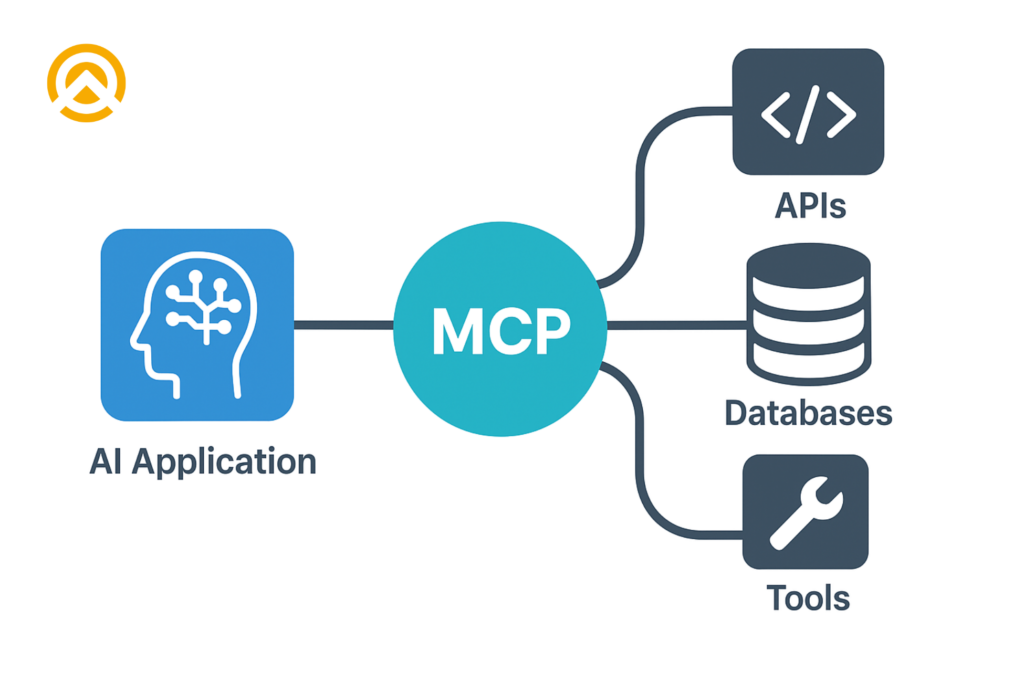MCP vs API: Which Is Better for AI Workflow Integration in 2026?
Introduction
As AI workflows grow more complex, businesses are rethinking how their large language models (LLMs) connect with data, tools, and external systems. Until recently, APIs were the backbone of digital integration, reliable, structured, and well understood. But in 2026, a new approach is reshaping the landscape: the Model Context Protocol (MCP).
MCP is designed specifically for AI-driven environments where adaptability, context awareness, and seamless interaction across tools matter most. While APIs continue to power traditional systems, MCP introduces a more dynamic way for AI applications to communicate and collaborate.
In this blog, we’ll explore what MCP and APIs really are, how they differ in purpose and design, and which approach best fits your organization’s AI workflow needs in 2026.
What Is MCP?

The Model Context Protocol (MCP) is an open standard designed to enable seamless integration between large language models (LLMs) and external tools, APIs, or data sources.
Unlike traditional methods where developers manually code connections for every tool, MCP allows AI systems to discover, access, and use external resources dynamically, without constant reconfiguration.
In simple terms, MCP acts as a universal translator between AI models and the ecosystem they operate in. It ensures that models don’t just process text but also understand context, the surrounding data, user intent, and relevant tools available to accomplish a task.
Why MCP Matters in AI Workflows
In 2026, enterprises are rapidly adopting AI agents capable of decision-making, reasoning, and multitool interaction. MCP provides the missing link that allows these systems to:
- Access live business data directly through a standardized interface.
- Switch tools automatically depending on task requirements.
- Maintain session-based context, enabling continuity across multiple actions.
This context-awareness transforms static AI systems into adaptive agents that learn, reason, and act based on situational data.
According to Anthropic’s 2025 update, MCP is already being integrated into AI development platforms to improve interoperability and reduce integration friction by up to 45% compared to manual API setups.
Real-World Example
Imagine an AI-powered project manager in a software development firm.
Using MCP, the AI can:
- Retrieve task updates from Jira,
- Pull performance metrics from a CI/CD pipeline,
- And communicate progress in Slack, all without predefined API coding.
The AI identifies the right tools, connects contextually, and coordinates actions across them automatically. This adaptability helps enterprises build self-sufficient AI workflows that respond dynamically to real-time conditions.
Pros of MCP
- Dynamic Integration: Adapts automatically to new tools or data sources without code rewrites.
- Context Retention: Maintains continuity across multi-step workflows, improving reasoning and task completion.
- Scalable and Efficient: Reduces manual integration efforts and developer workload.
- Future-Ready: Built for agentic AI systems that require reasoning across multiple platforms.
Cons of MCP
- Early-Stage Adoption: Still developing standards and ecosystem maturity.
- Security Concerns: Requires further refinement in authentication and permission controls.
- Limited Tool Support: Not yet as widely compatible as APIs.
- Learning Curve: Developers familiar with traditional APIs may need to adapt to new design principles.
What Are APIs in the Context of AI Integration?
An API (Application Programming Interface) is a set of rules that allows two systems to communicate and exchange information.
Think of it as a digital bridge that lets software applications “talk” to each other safely and efficiently.
In AI workflows, APIs are the backbone of integration. They allow chatbots, predictive models, and analytics systems to pull data or trigger actions automatically.
For instance, when an AI assistant retrieves weather data or stock prices, it doesn’t browse the web; it calls an API that returns structured data in real time.
Why APIs Matter
In 2026, as organizations integrate AI deeper into business systems, APIs remain essential for dependable and secure connectivity. They serve as the universal interface that allows large language models, automation tools, and data platforms to work together smoothly.
APIs enable AI-driven systems to perform real-time actions, fetch up-to-date insights, and communicate across diverse technologies without human oversight. Their stability, documentation, and wide adoption make them the most reliable way to operationalize AI across industries.
Even as newer protocols like the Model Context Protocol (MCP) evolve, APIs continue to provide the solid foundation that supports interoperability, scalability, and secure data exchange in AI ecosystems.
Real-World Example
Consider a retail company using an AI-driven personalization engine.
Through APIs, the system can:
- Access customer purchase data from the CRM,
- Pull product information from the e-commerce database,
- And trigger marketing automation tools for tailored promotions.
This consistent, structured data flow allows AI systems to act accurately and securely across different services.
Pros of APIs
- Mature Technology: APIs are well-documented, stable, and supported by nearly all modern software platforms.
- Security and Compliance: Proven authentication models like OAuth and API keys ensure secure data transfer.
- Performance Reliability: Consistent request–response communication ensures predictable system behavior.
- Widespread Compatibility: Works across cloud, web, and enterprise systems globally.
Cons of APIs
- Rigid Integration: Requires manual coding for every new tool or endpoint.
- Stateless Nature: Lacks memory between requests, limiting multi-step reasoning for AI agents.
- Maintenance Overhead: Needs updates whenever an endpoint or schema changes.
- Limited Context Awareness: APIs share data but not the reasoning context AI systems often require.
MCP vs API: Side-by-Side Comparison
The debate between Model Context Protocol (MCP) and Application Programming Interfaces (APIs) isn’t about which technology replaces the other. Instead, it’s about understanding which approach better fits modern AI-driven workflows.
While APIs have powered digital communication for decades, MCP introduces a new, context-aware framework tailored for the age of intelligent agents.
Let’s explore MCP vs API across key dimensions.
Integration & Maintenance
| Aspect | API | MCP |
| Setup Complexity | Each integration requires developers to configure endpoints, authentication, and data mappings manually. | MCP uses a unified layer where AI systems can discover and connect to tools automatically. |
| Maintenance | High, every API update or new service requires code changes. | Low, standardized protocol allows new tools to be integrated with minimal updates. |
| Scalability | Scales well for predictable systems but struggles with rapidly evolving AI ecosystems. | Built for scalability across dynamic AI environments with multiple interconnected agents. |
APIs excel when integrations are fixed and predictable. MCP, on the other hand, scales effortlessly as AI ecosystems evolve, making it more adaptive for future enterprise environments.
Workflow Flexibility and Context
| Aspect | API | MCP |
| State Management | Stateless; each request is independent. | Stateful; maintains session memory across multiple tool interactions. |
| Context Awareness | Limited: APIs lack built-in awareness of user intent or history. | Context-rich; allows LLMs to reason based on prior actions and environment. |
| Workflow Type | Linear, request-response workflows. | Dynamic, multi-step, reasoning-based workflows. |
Traditional APIs are ideal for single operations. But AI agents rarely work that way; they need to chain multiple steps and tools together intelligently.
MCP enables exactly that: an LLM can plan, execute, and adapt its actions based on feedback from prior steps.
For instance, in an AI-driven IDE, an API might fetch a file, but an MCP agent could analyze, refactor, and test the code, all while understanding the broader goal.
Tool Discovery and Extensibility
| Aspect | API | MCP |
| Tool Registration | Requires developers to manually configure endpoints and documentation. | Tools register automatically using standardized metadata. |
| Discovery | Static, predefined; each integration is explicitly declared. | Dynamic: agents can discover new tools at runtime. |
| Extensibility | Adding new services often requires version updates or redeployment. | New tools can be added without disrupting existing workflows. |
MeasureOne (2025) notes that MCP’s metadata-driven discovery reduces integration setup time by over 50% for AI platforms managing multiple services.
This discovery-based mechanism is why many experts see MCP as the foundation for agentic AI ecosystems.
Security and Governance
| Aspect | API | MCP |
| Authentication | Mature methods like API keys, OAuth, and JWT. | Uses API-style authentication, with potential support for more granular agent-based permissions. |
| Governance | Strong: built over years of enterprise-grade usage. | Emerging: evolving standards, especially around agent identity and access control. |
| Auditability | Each API call can be logged easily. | MCP supports traceability through context logs, but tools are still maturing. |
While APIs currently have the edge in maturity and compliance, MCP is rapidly catching up.
Developer Experience
| Aspect | API | MCP |
| Ease of Use | Well-documented; strong developer community. | Newer standard; limited documentation, but faster for AI-related use. |
| Customization | Requires coding and endpoint management. | Requires less manual setup, AI agents self-orchestrate. |
| Learning Curve | Familiar to most developers. | Easier for AI engineers; less so for traditional developers initially. |
The shift from API-first to AI-context-first development requires new thinking. Developers are no longer writing glue code; instead, they design environments where AI agents handle orchestration autonomously, an approach increasingly supported by specialized AI agent development services.
As one engineer noted in their 2025 report:
“MCP isn’t replacing APIs; it’s removing the friction between them. Developers are freed from manual integration work and can focus on designing smarter AI workflows.”
Scalability and Adaptability
| Aspect | API | MCP |
| System Growth | Scales are predictable but need individual integrations. | Scales naturally as AI systems discover and connect to new tools. |
| Adaptability | Slow to adapt to changing workflows. | Instantly adaptable to new tools, prompts, and tasks. |
| Automation Potential | Limited, relies on predefined scripts. | High supports fully autonomous AI agents with reasoning capabilities. |
By 2026, Gartner predicts that 70% of enterprises will use context-aware integration frameworks like MCP to power intelligent automation.
This adaptability is what makes MCP especially relevant in environments where workflows evolve in real time, like customer support, supply chain analytics, or AI-driven DevOps.
Performance and Reliability
| Aspect | API | MCP |
| Response Time | Fast and consistent due to direct calls. | Slightly higher latency due to contextual reasoning. |
| Reliability | Proven stability over decades. | Still evolving but designed for robustness in distributed AI systems. |
| Error Handling | Simple, predefined codes (e.g., 400, 500). | More sophisticated handling based on agent understanding and context. |
APIs remain unbeatable for high-performance transactional systems, like payment gateways or data analytics pipelines.
However, MCP’s ability to reason through failures (for example, retrying an action with a different tool) provides resilience that static APIs can’t match.
Business and Operational Impact
| Aspect | API | MCP |
| Time to Integrate | Weeks to months, depending on system complexity. | Days: thanks to dynamic discovery and minimal configuration. |
| Cost Efficiency | Requires continuous maintenance and developer input. | Reduces developer dependency and ongoing integration costs. |
| Innovation Velocity | Slower: bound by manual integration cycles. | Faster: AI agents can integrate new tools autonomously. |
In a 2025 McKinsey Digital Report, organizations that adopted AI-native protocols like MCP reported 35% faster deployment cycles and 25% reduction in integration costs compared to API-only architectures.
Summary Table: MCP vs API at a Glance
| Feature | API | MCP |
| Integration Method | Static, manual | Dynamic, AI-driven |
| Context Handling | Stateless | Context-aware |
| Tool Discovery | Manual | Automatic |
| Scalability | Predictable | Adaptive |
| Security | Mature | Emerging but improving |
| Best For | Legacy systems, predictable workflows | AI agents, dynamic and evolving workflows |
In essence, APIs remain indispensable, but MCP is the future-facing layer that enables true AI workflow orchestration. The ongoing MCP vs API comparison reflects this evolution, while APIs ensure stability and structured communication, MCP brings adaptability and context-awareness to AI-driven systems. For enterprises moving toward autonomous agents, real-time data interaction, and tool chaining, MCP offers a model built precisely for that world.
Also Read : How Model Context Protocol Enhances Long-Context Retention in AI Models
Which Approach to Choose
Choosing between MCP and APIs depends on your workflow goals, system setup, and long-term AI strategy. Each option has unique strengths that fit different kinds of organizations. Let’s look at when to use each and why.
Why Choose APIs
APIs are a great choice for businesses that want reliability, security, and control in their integrations. They work best when your systems follow a clear structure and don’t need frequent changes.
Choose APIs when:
- Your workflows involve stable and repeatable data exchanges, like CRM or ERP systems.
- You need strong security and compliance, especially in industries like finance or healthcare.
- Your integrations are developer-managed and rarely updated.
- You want real-time, accurate data transfer between known systems.
Example:
A financial analytics company uses APIs to connect its LLM-based dashboard with secure banking data and stock market feeds. Since the setup is regulated and consistent, APIs ensure safe and predictable performance.
Why Choose MCP
MCP fits modern, AI-driven environments where flexibility and context matter more than fixed rules. It allows AI models to connect, reason, and act across tools dynamically.
Choose MCP when:
- You use AI agents that must work across multiple tools or systems.
- Your business environment changes frequently and needs adaptive automation.
- You want AI to discover and connect to new resources automatically.
- You aim for context-aware decision-making instead of simple data exchange.
Example:
A global enterprise uses an AI assistant to manage projects, customer support, and communication. With MCP, it connects automatically to Slack, Jira, and Salesforce without manual setup, making automation faster and smarter.
The Hybrid Approach
Many organizations combine both MCP and APIs to get the best of stability and flexibility. APIs handle the structured data exchange, while MCP manages dynamic coordination between tools.
Choose a hybrid model when:
- You already use APIs but want to add context-aware automation.
- You need to maintain security and compliance while scaling AI.
- You are moving gradually toward AI-native systems without replacing existing ones.
Example:
A healthcare provider keeps its secure API setup but adds MCP to let its AI assistant coordinate between patient records, appointment systems, and insurance tools. The result is smooth, compliant, and intelligent automation.
Why Choose Amplework for AI Workflow Integration
As organizations transition toward MCP-driven AI ecosystems, having the right technology partner becomes crucial. Amplework Software stands out as a trusted leader in delivering AI integration services, building scalable, intelligent, and secure AI workflows for enterprises worldwide.
Here’s why:
1. Expertise in Hybrid AI Integration
Amplework bridges traditional API systems with advanced MCP frameworks to ensure seamless interoperability and context-aware AI workflows.
2. Proven Experience in AI Solutions
From LLM-powered chatbots to data-driven analytics, our team delivers enterprise-grade AI integrations that are both reliable and scalable.
3. Security and Compliance First
We embed enterprise-level controls across every project, ensuring data integrity and compliance with GDPR, SOC 2, and other standards, no matter your industry.
4. Future-Ready AI Strategy
Amplework helps you design MCP-ready workflows that evolve with your data, ensuring your AI infrastructure stays adaptive and cost-efficient over time.
5. Complete Partnership Approach
We go beyond integration, offering consulting, deployment, and ongoing optimization so your AI systems perform flawlessly from concept to rollout.
Final Thoughts
In 2026, AI workflow integration is evolving from simple connectivity to intelligent collaboration. While APIs have long served as the backbone of digital communication, the Model Context Protocol (MCP) is redefining how systems think, adapt, and interact. The ongoing debate of MCP vs API highlights a shift toward smarter, more dynamic ecosystems. The future of AI lies in creating workflows that are not only efficient but also context-aware and autonomous. Choosing between APIs and MCP depends on your organization’s maturity and integration goals. Partnering with an experienced AI development company can help you navigate this transition effectively. APIs deliver reliability and control, while MCP enables flexibility and adaptive intelligence, together powering the next generation of AI-driven business ecosystems.
Frequently Asked Questions
Is MCP replacing APIs completely?
No, MCP is not replacing APIs. Instead, it builds on them. APIs remain the foundation for data exchange and secure connectivity, while MCP adds context-awareness and dynamic tool discovery on top. In most cases, MCP works with APIs rather than replacing them entirely.
Why is MCP important for AI workflow integration?
MCP enables AI systems to understand context, maintain memory, and interact dynamically with multiple tools or data sources. This makes it ideal for AI agents, autonomous systems, and complex workflows where static, request–response APIs fall short.
Can traditional API systems integrate with MCP?
Yes. Many organizations use a hybrid approach where APIs handle structured data transfer, and MCP manages adaptive coordination across tools. This combination ensures both stability and intelligence in enterprise AI workflows.
What industries can benefit most from MCP?
Industries with high automation potential, like finance, healthcare, logistics, and software development, benefit the most. MCP allows AI agents to connect securely with multiple systems, manage real-time data, and make context-based decisions without manual reconfiguration.
How should enterprises prepare for the shift from API to MCP?
Enterprises should start by mapping their existing integrations, identifying workflows that can benefit from context-aware automation, and testing small-scale MCP pilots. With expert AI consulting services, organizations can strategically plan this transformation. Gradually adopting MCP alongside existing APIs helps ensure a smooth transition and long-term scalability.


 sales@amplework.com
sales@amplework.com
 (+91) 9636-962-228
(+91) 9636-962-228





